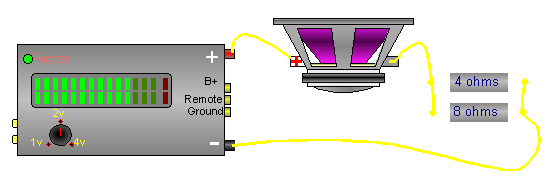You may need a calculator if you aren't good with fractions.
You work out the parallel parts first, by finding the reciprocal (one divided by the number) of all the components' reciprocals added together. EG, I have two 4ohm subs, wired in series. .
1/(total resistance) = (1/R1) + (1/R2) + (1/R3)...
1/(total resistance) = 1/4 + 1/4
1/(total resistance) = .25 + .25
1/(total resistance) = .5
Total resistance = 2 ohms, so I get a two ohm load
Then you work out the series part, by adding the impedances together. So for 3 subs, 4ohms each, two in parallel and one in series.
I'd have 1/4 + 1/4 = 1/2, so 2ohms + 4ohms gives a 6 ohm load.
(found this image and text with sums it up nicely)
![Image]()
Parallel components:
Total parallel resistance = (R1*R2)/(R1+R2)
Total parallel resistance = (4*8)/(4+8)
Total parallel resistance = 32/12
Total parallel resistance = 2.67 ohms
Total parallel plus Series:
Total resistance = R1 + R2
Total resistance = 4 + 2.67
Total resistance = 6.67 ohms total
Further more, if a component is parallel to a series, the series component is worked out first, followed by the parallel and then any other series. But that's just good maths. Just made this quickly in paint to explain what I mean:
![Image]()
Think of it like rules to working out an equation, but instead of BIDMAS, it's paralleled series, parallel, then series.
You work out the parallel parts first, by finding the reciprocal (one divided by the number) of all the components' reciprocals added together. EG, I have two 4ohm subs, wired in series. .
1/(total resistance) = (1/R1) + (1/R2) + (1/R3)...
1/(total resistance) = 1/4 + 1/4
1/(total resistance) = .25 + .25
1/(total resistance) = .5
Total resistance = 2 ohms, so I get a two ohm load
Then you work out the series part, by adding the impedances together. So for 3 subs, 4ohms each, two in parallel and one in series.
I'd have 1/4 + 1/4 = 1/2, so 2ohms + 4ohms gives a 6 ohm load.
(found this image and text with sums it up nicely)

Parallel components:
Total parallel resistance = (R1*R2)/(R1+R2)
Total parallel resistance = (4*8)/(4+8)
Total parallel resistance = 32/12
Total parallel resistance = 2.67 ohms
Total parallel plus Series:
Total resistance = R1 + R2
Total resistance = 4 + 2.67
Total resistance = 6.67 ohms total
Further more, if a component is parallel to a series, the series component is worked out first, followed by the parallel and then any other series. But that's just good maths. Just made this quickly in paint to explain what I mean:

Think of it like rules to working out an equation, but instead of BIDMAS, it's paralleled series, parallel, then series.




